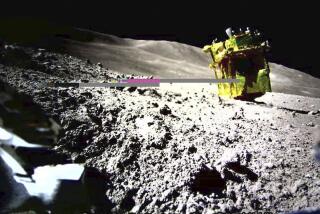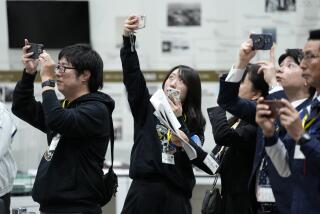Japan’s Mars Spacecraft Still Faces Difficult Odds
- Share via
The Nozomi spacecraft -- Japan’s first mission to Mars -- successfully swung past Earth on Thursday, passing a milestone in its long, and star-crossed, journey.
The $88-million Nozomi, the Japanese word for hope, should reach Mars by January -- more than four years behind schedule. Despite the success of its flyby maneuver Thursday, its odds of reaching the planet are still daunting.
Originally scheduled to send back data on the Martian atmosphere in October 1999, Nozomi faced a series of setbacks that left it behind schedule, low on fuel and short a heating system.
Nozomi’s first swing by Earth in December 1998 burned too much fuel and left the space probe with too little speed. To conserve fuel and save the mission, Japanese scientists decided to take a longer route to Mars, requiring two additional passes near Earth, using our planet’s gravity to give the spacecraft the boost it will need to arrive by early 2004.
Jim Hodder, an operations manager at NASA’s Jet Propulsion Laboratory in Pasadena, said Nozomi’s convoluted path is a fairly routine way of transporting spacecraft to other planets, one that has been used to send the NASA spacecraft Galileo to Jupiter and Cassini to Saturn.
Unfortunately, as Nozomi approached the Earth in April 2002 for its second flyby, an unexpected burst of solar energy temporarily cut off communication with the space probe, according to Japanese government officials. Though communication has been restored, damage to a heating system responsible for keeping the probe’s fuel from freezing has left many questioning whether the spacecraft will have enough thawed fuel to establish an orbit around Mars.
“The main thing is getting this heating system working,” said David R. Williams, a planetary scientist at the National Space Science Data Center. “That’s the real showstopper.”
If too much fuel is frozen when the spacecraft reaches its destination, it could sail past Mars, taking all of its scientific instruments, including a spectrometer provided by NASA’s Goddard Space Flight Center, on a joy ride into deep space.
“I think there is a 50% chance of succeeding in mending the Nozomi spacecraft based on the information I have at the moment,” Yasunori Matogawa, director of Japan’s Kagoshima Space Center, told BBC News Online.
NASA’s two rovers, Spirit and Opportunity, and the European Space Agency’s Mars Express probe and Beagle-2 lander are also expected to reach Mars by January.






